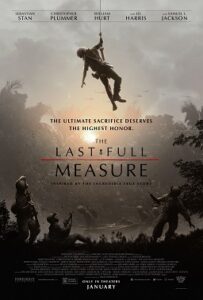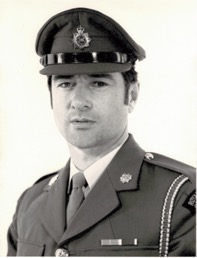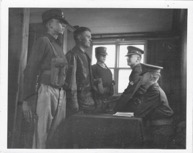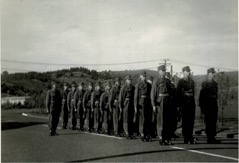
Greetings Fellow Clubbies.
Welcome to the 24th As You Were! monthly blog post. Shout yourself a glass of whatever takes your fancy as you read this.
Aren't these wondrous times we live in? We are about to become traffic-lighted but, who knows for how long - the latest Omicron variant of Covid may have us all back into lockdown levels (it's already been detected in Aussie) before we can even line up at the lights!
To escape from all this despondency and gloom, I watched a movie on TV on Saturday morning to relax me before I did the grocery shopping. Well, it turned out to be a rip-snorter, although "very American" as Bob put it after he had watched it. The Last Full Measure, which has a stellar cast, tells the story of... well, Wikipedia says it better than I can:
 "The true story of Vietnam War hero William H. Pitsenbarger, a U.S. Air Force Pararescueman (also known as a PJ) who personally saved over sixty men. During a rescue mission on April 11, 1966, Pits (as he was called) willingly chose to leave the relative safety of his rescue helicopter to aid people on the ground when he saw how bad the situation below was. When others in his team declined to go, he put himself at risk to do more to help his fellow Americans. After saving many already, he was ordered to take the chance to escape on the last helicopter out of a combat zone heavily under fire, but he stayed behind to save and defend the lives of soldiers of the U.S. Army's 1st Infantry Division, before making the ultimate sacrifice in one of the bloodiest battles of the war.
"The true story of Vietnam War hero William H. Pitsenbarger, a U.S. Air Force Pararescueman (also known as a PJ) who personally saved over sixty men. During a rescue mission on April 11, 1966, Pits (as he was called) willingly chose to leave the relative safety of his rescue helicopter to aid people on the ground when he saw how bad the situation below was. When others in his team declined to go, he put himself at risk to do more to help his fellow Americans. After saving many already, he was ordered to take the chance to escape on the last helicopter out of a combat zone heavily under fire, but he stayed behind to save and defend the lives of soldiers of the U.S. Army's 1st Infantry Division, before making the ultimate sacrifice in one of the bloodiest battles of the war.
Thirty-two years later, Pentagon staffer Scott Huffman, on a career fast-track, is reluctantly tasked with investigating a Medal of Honor request for Pitsenbarger made by Pits' parents and by Tom Tulley, Pits' best friend and partner on the mission. Huffman seeks out the testimony of Army veterans who witnessed or were saved by Pitsenbarger's extraordinary valor, including Takoda, Burr and Mott. Many of them carry their own demons from their experiences and trauma of that day and the war in Vietnam. But as Huffman learns more about Pitsenbarger's courageous acts, he uncovers a high-level conspiracy behind the decades-long denial of the medal, prompting him to put his own career on the line to seek justice for the fallen airman.
Throughout the film in multiple flashback scenes, the Vietcong ambush of Army soldiers as they fight and die in the Vietnam jungle is shown in graphic realism. The attack is known as Operation Abilene. The 1966 versions of Tulley, Takoda, Burr, Mott, Kepper, Holt, and Pitsenbarger are shown in the fight. One sees the heroic service of airman Pitsenbarger as he drops into the firefight from a helicopter and goes to work as a medic. He waves off the helicopter, picks up a gun and starts to fight with his comrades. Saving many, he dies a hero. The film also details the PTSD effect on each of the now old surviving veterans of the Vietnam War.
When a Senate effort on the floor of Congress fails, Huffman goes public with the story and ultimately a Medal of Honor is awarded to Pitsenbarger. At the awards ceremony Mott delivers Pitsenbarger's last letter to the woman he loved. The airman's cancer-ridden father and mother are in attendance as their son's duty, courage and sacrifice is recounted. The Air Force Secretary presents the Medal of Honor to the parents and then recognizes all in attendance. The epilogue points out that of the 3,489 Medals of Honor awarded as of 2019, only three had been to enlisted Air Force personnel." https://en.wikipedia.org/wiki/The_Last_Full_Measure_(2019_film)
Bob noted that the movie's combat took place in Phuoc Tuy Province (in April 1966) which is where the battle of Long Tan was fought (in August of that same year). We wrote about Morrie Stanley (one of the NZ heroes of that battle) in the January 2020 post for this blog. Strangely enough, I switched the telly on to the History Channel today and found that a documentary on Long Tan was playing (https://www.youtube.com/watch?v=TSoi28LPbfc). Because it didn't pretend that Morrie Stanley was an Aussie (as the film 'Danger Close' did) I found it more authentic than that film.
In this issue we pay tribute to Pete Sheppard (no crowing from Gentry Class please - we know that our last tribute was to a classmate of Pete's - Kevin Herewini) and include a poem written about Long Tan by a Clubbie (Russell Class) soldier - John Moller, RNZIR. (Apologies for not getting your permission in advance to publish this poem, John.)
Tribute - one of our own
Captain Peter Sheppard, BEM, FCILT, RNZCT, Gentry Class
Peter was born in Whanganui in 1946 and entered the RF Cadet Schools as a member of Gentry Class nineteen days after turning 15 in January 1962. “This new way of life created some important threshold levels which I rely on still. Working with others, supporting people, and always gaining more knowledge.” He explains: “During those years, we also had our own barrack room justice and the photo to the left shows our section commander undergoing a mock orderly room for obviously something he never did!.” He took his punishment on the chin!
“The first year in the RF Cadets saw me removed from the school certificate class and placed in the general education class and then onto familiarisation training at the various army corps schools. This is what I had joined the Army for, to be out running around the hills playing soldiers! My removal from the school certificate class only echoed my school reports I had received over the years which stated I had no academic interest, only wanted to be out playing sports. Notably, later in life I gained school cert English by correspondence and was part of a world first research project on adolescent frontal lobe development. I also presented my own research paper on incentive programmes, to a packed Sydney Convention Centre.”
Peter was promoted to cadet sergeant in his senior year but because of a disagreement with his cadet CSM was demoted to corporal. “In my view, he made his own rules”.
Regardless, on graduation into the RNZASC Peter held prizes for best platoon, best drill platoon and best RNZASC cadet.
“On leaving the RF Cadets, my career path took me as an instructor at the National Service Training Unit and then to the Regular Force Training Depot where all new Army recruits underwent their basic training. In 1968 my next posting was to the NZ Headquarters based alongside the British and Australian Forces in Singapore. This posting was very fortunate as I had only been married for seven months. At the end of this posting in 1970, I returned to Waiouru as a Transport Instructor at the Army’s Transport School and had the chance of really specialising in driver education. In 1974 I was off to Wellington for the first of two postings at the Transport Directorate. Life in the city certainly refocused my thoughts on how close Army training was to civilian life and I had an opportunity to experience working with civilian and Government organisations with fleet management and road safety. Needing extra money to build a house, I worked in the evenings and weekends for a civilian driving school. This experience later in life tuned out to be most valuable. In 1977 I returned to Singapore for a second posting where I was the NZ Transport Squadron Sergeant Major. At the beginning of this posting, I received the British Empire Medal (BEM) for work I had undertaken in the Transport Directorate.
In 1979, on completing my second posting to Singapore, the NZ Government accepted a request from the Singapore Government for assistance in developing Driver Education and prior to returning to NZ. I spent six months on secondment to the Singapore Government developing Defensive Driver Training and motorcycle courses.
In 1980, on return to NZ from this secondment, I was promoted to Warrant Office Class One as the Army Transport School Sergeant Major at Waiouru. I spent two other short secondments to the Papua New Guinea Defence Force implementing Defensive Driving programmes and along with two other NZ Army officers, we were the first NZ Army personnel to be exchanged with the US Army in Hawaii. This secondment influenced the NZ Army’s bid to provide a driver training team into the Sinai Desert. The newly established Multinational Force and Observers (MFO) experienced many vehicle incidents, and a tender was placed among the thirteen contributing nations to provide a driver training team. In 1983 NZ Army made a bid, it was accepted, and I was required to select a team of transport instructors to take to the Sinai Desert and establish a driver training regime, which is still active.”
Peter retired from the Army in 1987. I have extracted the following record from a biography on Peter that catalogues his impressive accomplishments in road transport since graduation:
From having a long association with the driver education environment both within NZ and internationally, Peter is looked upon as one of NZ’s leading professional specialists in driver education and transport safety management. Following six years as the Chief Executive of the AA Driver Education Foundation he moved to the DEF Board. He is a past chairman and board member of Tranzqual Industry Training Organization, a position he held during the organization’s first 15 years of operations. Prior to the AA Driver Education Foundation, Peter spent 15 years with Shell NZ, finishing as the Principal Road Transport Consultant. His Shell career followed a 25 year career as a transport officer in the NZ Army. His current responsibilities include honorary CEO position with the NZ Institute of Driver Educators, developing and certifying driver educators, and advisory roles with various NZ Government Agencies. More recently, he was appointed as the Technical Director for the Holden Street Smart Driving Programme, (now Street Smart NZ), a new nation-wide programme for young drivers.
Peter’s work in fleet safety management, fuel efficiency and driver education has involved developing new driver education initiatives and incentive programmes for young drivers, co-authoring a “world first” research project (in conjunction with Waikato University) aimed at adolescent drivers frontal lobe development. Peter has presented a range of papers both locally and internationally on adult driver education, driver crash-risk profiling and crash causation. He has arranged several conferences and seminars, involving some of the world’s leading researchers in driver behavior and workplace road safety. His time has also been spent upskilling driver educators, designing driver training interventions, developing programmes for parents to teach their families to drive and providing governance for driver education interventions such as Students Against Dangerous Driving (SADD).
In 2007, Peter was voted NZ Personality of the Year for his work in Road Safety and driver education, receiving the prestigious Neil Nelson award from the NZ Motor Writers Guild.
In 2008, Peter was seconded to the Ministry of Transport as a project manager for the Fleet Commitment Fuel Efficiency Programme and in 2009, he was responsible for developing the NZ fuel efficiency programme for it’s 2010 implementation into the NZ vehicle fleet. Peter was also the coach of the 2008 winning TradeMe team in the NZ Energy Wise car rally.
More recent work has been the development and implementation of Electric Vehicle programmes for the introduction of these vehicles into the New Zealand vehicle fleet.
Peter is a Chartered Fellow of the Chartered Institute of Logistics and Transport and a Past Chairman of the Institute’s Central Section. Peter is also previous member of the NZ Institute of Directors.
“My career has been challenging, satisfying, and rewarding since I stepped on that coach in Wanganui in 1962. I owe so much to my “Brothers In Arms” for their support, guidance and particularly, through those most formative years I spent in the RF Cadets.”
Peter has served not only the Army well but New Zealand, international organisations and other countries too. Without doubt he is a true exemplar of the RF Cadet School. Fortes Fortuna Juvat.
Thanks to Bob Davies for co-ordinating this tribute.
Military Arts
A Salute to the Men of Long Tan
Kiss your wives and farewell your friends
it’s time my lads to stand with the men,
bloodied red bayonets and mouths painful dry
bandage your brothers, and try not to cry.
The Vietcong are coming all black down the road
so take up your rifles and aim well and load,
forget all your dreams and remember your past
I fear that this battle may well be your last.
Stay firm in the trenches, shoot slightly low
ignore dying friends as the cannon mouths glow,
the enemy are evil and slavery their name
so fix tight your bayonets and mark well the aim.
So kiss all your wives and hug tight your child
for today is the day when death will run wild,
the tracer bright ribbons will cut them down clean
in the eddies of battle by dirty brown streams.
So hold tight your brothers and farewell your babes
today is the day you’ll be in your graves,
falling and calling in cordite’s white cloud
the jungle forever your lonely brave shroud.
So remember my friends those D Company men
who laid down their lives in Long Tan’s green glens,
salute all your sons and the seventeen lost
who paid for our freedom, the ultimate cost.
©Lt. John A. Moller
Whiskey Two Company RNZIR




